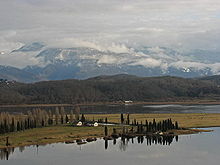
Ecuador is a country in western South America, bordering the Pacific Ocean at the Equator, for which the country is named. Ecuador encompasses a wide range of natural formations and climates, from the desert-like southern coast to the snowcapped peaks of the Andes mountain range to the plains of the Amazon Basin. Cotopaxi in Ecuador is one of the world's highest active volcanos. It also has a large series of rivers that follow the southern border and spill into the northwest area of Peru.

Georgia is a country in the Caucasus region, on the coast of the Black Sea. Sometimes considered a transcontinental country, it is located at the intersection of Eastern Europe and West Asia, and is today generally regarded as part of Europe. It is bordered to the north and northeast by Russia, to the south by Turkey and Armenia, and to the southeast by Azerbaijan.

Russia is the largest country in the world, covering over 17,125,192 km2 (6,612,074 sq mi), and encompassing more than one-eighth of Earth's inhabited land area. Russia extends across eleven time zones, and has the most borders of any country in the world, with sixteen sovereign nations.
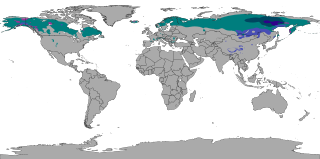
The subarctic climate is a continental climate with long, cold winters, and short, warm to cool summers. It is found on large landmasses, often away from the moderating effects of an ocean, generally at latitudes from 50°N to 70°N, poleward of the humid continental climates. Subarctic or boreal climates are the source regions for the cold air that affects temperate latitudes to the south in winter. These climates represent Köppen climate classification Dfc, Dwc, Dsc, Dfd, Dwd and Dsd.

The Caucasus Mountains is a mountain range at the intersection of Asia and Europe. Stretching between the Black Sea and the Caspian Sea, they are surrounded by the Caucasus region and are home to Mount Elbrus, the highest peak in Europe at 5,642 metres (18,510 ft) above sea level.

Temperate rainforests are rainforests with coniferous or broadleaf forests that occur in the temperate zone and receive heavy rain.
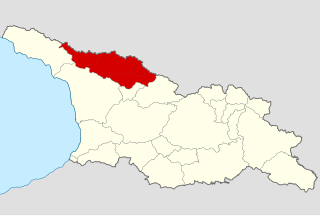
Svaneti or Svanetia is a historic province in the northwestern part of Georgia. Running along the Greater Caucasus range, Svaneti is one of the most mountainous regions of Georgia. It is largely inhabited by the Svans, an ethnic subgroup of Georgians.

Meskheti Range is a part of the Lesser Caucasus mountain range in Meskheti region, in southwestern Georgia.

Trialeti Range is an east-west mountain range of the Lesser Caucasus Mountains in the Samtskhe–Javakheti region of southern Georgia.

The Bzyb or Bzipi is one of the two largest rivers of Abkhazia and the twelfth longest river in Georgia. The river valley has rich biodiversity of herbaceous garden plants, particularly in the gorge section in the upper reaches where the most prominent and colourful bellflower Campanula mirabilis with profuse growth of 100 flowers per plant is given the name, the "Queen of the Abkhazian flora". During 1904-1917 it served as the border between the Russian Empire's Sukhumi Okrug and the Black Sea Governorate.

Mount Agepsta is a mountain in the Gagra Range of the Caucasus Mountains system located in Abkhazia, Georgia.

The climate of Azerbaijan is very diverse. Nine out of eleven existing climate zones are present in Azerbaijan.

The Caucasus mixed forests is a temperate broadleaf and mixed forests ecoregion in the Caucasus Mountains, as well as the adjacent Lesser Caucasus range and the eastern end of the Pontic Mountains.

The total forest area of Azerbaijan is 1,021,880 ha or 11.8% of the country's area. The forest biomes consist of temperate deciduous forests, temperate broadleaf and mixed forests, temperate coniferous forests and riparian forests. Specialists estimate that in the 8th-9th centuries the forest cover was around 30-35%, most of it situated in mountainous areas.

North Ossetia Nature Reserve is a Russian 'zapovednik' in the high mountains on the northern slope of the Caucasus Mountains with the heights ranging from 650 meters - 4,249 meters. There are 76 glaciers in the reserve with a total area of 37 km2 (14 sq mi). The site is centered on the Ardon River valley, in the Alagirsky District of North Ossetia-Alania. It was formally created in 1967, and covers a total area of 29,000 ha (110 sq mi).
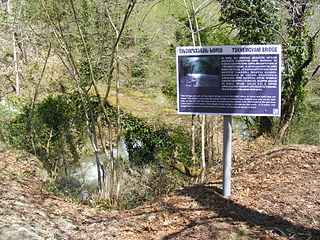
Kintrishi Strict Nature Reserve is a protected area in Kobuleti Municipality, Adjara region of Georgia in the upper part of the Kintrishi River at an altitude of 300–2,500 meters above sea level between the village of Tskhemvani (Tskhemlovana) and Khino Mountain in the Meskheti Range. It was established in 1959 to preserve relict humid forests and wetlands, in addition to its high number of endemic and threatened flora and fauna. Because of the ancient forests and high biodiversity within the nature reserve, it was inscribed on the UNESCO World Heritage List in 2021 as part of the Colchic Rainforests and Wetlands site.
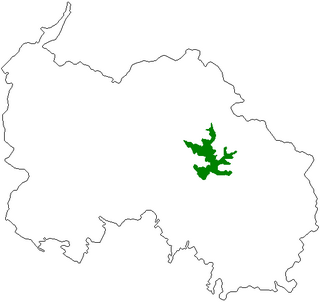
Liakhvi Strict Nature Reserve is a protected area in the historic region Shida Kartli on the southern slope of the Greater Caucasus range in the northeastern part of Tskhinvali District and in Akhalgori Municipality of Georgia. The reserve's main goal is protecting flora and fauna in surrounding mountainous region. In general Patara Liakhvi gorge has many tourist attractions : ethnological, bird-watching and botanical.

Yalta Mountain-Forest Nature Reserve is a protected nature reserve that covers the southwestern ranges of the Crimean Mountains, along the south coast of the Crimean Peninsula. The reserve is in the administrative district of Yalta Municipality
Aapsta is a river in Abkhazia, Georgia. It originates on the southern slopes of the Achbikhvdar ridge in the Gudauta pass area in beech forests at 1445 meters above sea level; flows into the Black Sea between the village Tskuara (Primorskoe) and the city Gudauta.

Egrisi Range, also known as the Samegrelo Range or the Odishi Range, is an east–west mountain range that runs parallel to the Greater Caucasus Mountain Range in the Samegrelo-Zemo Svaneti region of Georgia. The Range is connected to the Greater Caucasus Mountain Range via the Svaneti Range. The length of the Egrisi Range is 62 kilometres and the width is 37 kilometres. The Range is bounded by the Tskhenistsqali River Valley to the east and the Enguri River Valley to the west.



